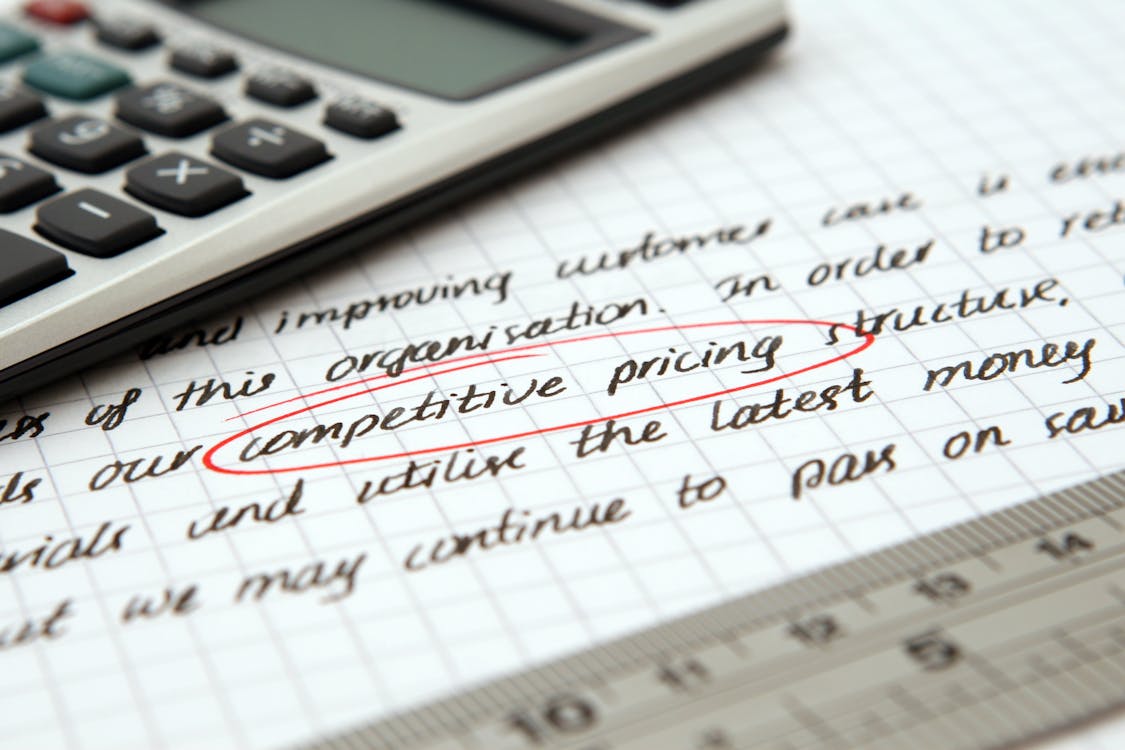What constitutes a pricing plan?
Numerous aspects of your organization, including target audience, positioning for the brand, revenue targets, marketing objectives, and product features are taken into consideration by pricing strategies. They are also impacted by outside variables such as general market and economic trends, rival pricing, and customer demand.
It’s normal for company owners and entrepreneurs to gloss over pricing. They frequently examine the cost of goods sold (COGS), take into account the prices of their rivals, and make minor adjustments to their selling price. Even while your competition and cost of goods sold are significant, your pricing strategy shouldn’t be centered around them.

The concept of a pricing strategy
The product to be sold, the sales channels where the product will be sold, and the advancement of the product to potential buyers make up the other three “4 Ps” of the marketing mix, which also includes pricing. Businesses can choose how much to charge for their products and services using a personalized pricing procedure that takes the other three elements into account.
For instance, a product’s quality in comparison to its rivals’ offerings can assist assess whether a premium pricing approach is viable, and a product’s location can indicate whether a dynamic pricing strategy is even feasible. A lot of pricing methods and promotional strategies work together. To give consistent discounts, some pricing strategies like high-low pricing require interaction with promotions.

Example of a Pricing Strategy
Prices are dynamic rather than constant. Let’s examine the development of MCR T-Designs, a fictitious T-shirt firm, from beginning to a major player, and the changes it undergoes in terms of pricing strategy.
MCR, a firm that sells T-shirts with amusing messages at well-liked holiday spots, has become instantly well-known. The owners use the approach of penetration pricing to help them achieve their goal of increasing market share by undercutting rivals and attempting to establish a name for themselves while also producing as many sales as they can to get the business off the ground.
At the height of this year’s tourist season, a hurricane shuts down some of MCR’s best sites. Due to the company’s heavy inventory purchases made in anticipation of never-materializing revenues, expenses are mounting without any revenue.
The result?
Consequently, MCR’s priorities shift from expanding market share to surviving. To close the sales gap, this necessitates a complementary approach that involves liquidating inventory at a discount and increasing investments in social media and online sales, whatever it takes.
MCR survives the storm and comes out stronger than it was. The owners have reoriented their primary goal to pursue profit to achieve more consistency in pricing and profits going forward. They determine that a cost-plus model is the most effective way to accomplish this, guaranteeing that each sale makes a solid profit and that prices never deviate too much from their expenses.

Pricing strategy example
All of the techniques a business owner employs to decide on the appropriate price for a good or service are collectively referred to as a pricing strategy. Putting a winning strategy into practice usually involves some math, market research, or gathering customer insights beforehand.
Naturally, not all pricing strategies are exhaustive. Using manufacturer-suggested retail prices (MSRPs) or predetermined markups also referred to as cost-plus pricing allows some business owners to keep things simple. You currently have a pricing plan in place if you establish your rates using any kind of regular procedure. You will be able to get a competitive edge in your business, though, if you develop a strategy that more fully takes into consideration the state of the market and other elements that affect consumer behavior.

Strategies of pricing
The following strategies of pricing address the most typical areas of interest for businesses during the pricing process:
Survival-Oriented
Depending on the danger, survival mode will look a little different, but companies must match their pricing strategy to their most pressing requirements while simultaneously making efforts to secure a more prosperous future.
Profit-Oriented
Aside from nonprofit organizations, one of the main, if not the default, goals of enterprises is financial gain. It means coming up with a pricing plan that, for certain companies at least, includes a respectable profit margin, which is frequently determined by the industry in which the company operates.
Sales-Oriented
For whatever reason, a price target that focuses on sales will try to increase sales overall or of particular kinds. The specifics of the targeted push will be useful in figuring out the best price plan to nudge clients in the right way.
Image-Oriented
Certain organizations employ pricing techniques to reinforce a specific brand image. For instance, producers of luxury goods usually decide to maintain their high prices and would prefer to have unsold inventory to be sold at a loss, fearing that this would damage their brand’s reputation in the long run.
Market-Share Oriented
Similar to choosing sales as an objective, choosing market share has a clearer end goal in mind: businesses aiming to gain a bigger portion of the market’s clientele.

Competitive pricing strategies
Rather than positioning prices only on costs or profit margins, competitive pricing intentionally chooses price points for goods or services based on competition pricing in your market or niche. Since the prices of these products frequently approach a point of equilibrium, companies that offer the same or very comparable products in a comparable market for an extended length of time typically utilize competitive pricing.
Setting prices based on those of your competitors is known as a competitive pricing strategy. This pricing strategy ignores factors such as production costs and customer value, concentrating only on the public prices of your competitors.
Thorough market research is the foundation of a robust, competitive pricing plan.
You can set the rates for your items or services based on your understanding of the prices of the leading rivals in your market and how those costs might satisfy customers. A company can choose to always offer the lowest price compared to its competitors or to always give the average price between the highest and lowest priced options as examples of competitive pricing strategies.

Competitive pricing strategy example
We’ve provided some examples below to help you better understand how to use competitive pricing in your company’s selling strategies:
Higher Price Strategy
The two biggest rivals in the point-and-shoot cameras market are Companies A and B. Company E is a new brand that is looking to get into the market and is researching its competitors. It is discovered that while Company B sells a digital point-and-shoot device with more sophisticated functions for $425, Company A sells a camera with basic features for $350. After that, Business E decided to produce a $500 “premium” digital point-and-shoot camera with even more sophisticated features. Although Company E charges a higher price, its superior features allow customers to rationalize the extra expenses.
Lower Price Strategy
The price of Company A’s wireless headphone model is $150. To attract budget-conscious customers who are comparing pricing between other companies, Company B, their closest rival in the market, offers their comparable type of wireless headphones for $140.
Equal Price Strategy
Within the market for bio-acetate eyewear, Company A enjoys great popularity. In an attempt to enter the market, Company B investigates its rival, Company A. It discovers that Company A charges $90 for its bio-acetate eyewear. In an attempt to persuade buyers to pay a “lower” price, Company B chooses to use an equivalent price competitive pricing approach and sells their comparable bio-acetate sunglasses for $89 instead.

Pricing strategy types
To assist businesses maximize their sales and profitability, a variety of pricing techniques are available, some of which are mentioned below:
Usage-Based Pricing
With usage-based pricing, clients pay only for the goods and services they use as opposed to a set amount. Businesses can modify their prices using this pricing strategy in response to client demand and usage.
Value-Based Pricing
A value-based pricing approach bases a company’s price on the value that customers believe its goods and services are worth. In addition to taking the competition and market conditions into account, this strategy also takes into account the needs, wants, and wishes of the client.
Competitive Pricing
Competitive pricing is essential to any business plan. It entails determining the going rate for comparable products provided by rival companies when determining the pricing of goods or services.
Price Skimming
A tactic known as “price skimming” involves first offering products or services at a premium price while progressively lowering it over time.
Cost-Plus Pricing
A profit margin is added to the cost of manufacturing or delivery to establish the final price when using the cost-plus pricing approach.
High-Low Pricing
One of the most widely utilized pricing techniques in business today is high-low. It entails listing prices that are high and then offering large discounts on them sometimes.
Dynamic Pricing
Companies use dynamic pricing to modify their product and service prices in response to shifting market dynamics.
Penetration Pricing
Setting a low starting price for a good or service, usually before launch, is known as penetration pricing. The goal is to draw clients in rapidly and increase market share.
Absorption Pricing
The selling price of a good or service is used to cover costs associated with manufacturing, operations, and other costs under the approach known as absorption pricing. It is sometimes referred to as cost-plus or full-cost pricing.
Geographic Pricing
Setting pricing for goods and services according to a customer’s or consumer’s location is known as geographic pricing.

Best pricing strategy
The circumstances of each unique organization usually dictate the optimal pricing plan. Certain tactics will be simple to include or exclude. Another significant element is the company’s pricing power. The only restrictions on a company’s ability to set prices are legal and political if it is the exclusive supplier of a good or service, lacking rivals or near replacements.
Competition-based pricing becomes increasingly significant as a business’s ability to vary from current rates decreases with increased competition. If it’s unique from everything else available, the company might be able to differentiate itself from rivals and set its cost-plus markup. Similarly, value-based pricing might be used in conjunction with hourly or project-based pricing to suit the needs.
Businesses can also research the prices and pricing tactics of their rivals to find out if they are bundling, employing dynamic pricing, changing their rates according to regions, and other tactics. Lastly, companies should be willing to try a little bit of experimenting to determine what kind of pricing suits both their needs and those of their clients.

Different kinds of pricing strategies
Here are a few of the more diverse and different kinds of pricing strategies that businesses utilize:
Dynamic Pricing
Dynamic pricing adjusts prices to a product’s current market demand. This pricing method, sometimes referred to as demand pricing, is particularly common when the product in question experiences daily or even hour fluctuations.
Bundle Pricing
When multiple comparable goods or services are offered for a single price, it is called bundle pricing. Bundling is a useful strategy for upselling clients on more items or adding value to their purchases.
Psychological Pricing
By subtly changing the price, product positioning, or product packaging, psychological pricing tactics take advantage of consumer psychology.
Premium Pricing
Whenever prices are set above the competition to create the impression of value, quality, or luxury, this is known as premium pricing.
Economy Pricing
Economy pricing undercuts rivals to turn a profit from large volumes of sales. Decreased production costs are typically associated with this kind of pricing strategy.

Best pricing strategies
The list of factors that affect pricing is extensive and includes rivals, production costs, consumer demand, industry requirements, profit margins, and more. It might be overwhelming to consider all of them at once. Fortunately, you don’t need to become an expert in every one of these areas right now.
Just take a seat, run some figures (such as your COGS and profit targets), and determine what matters most to your company. This can assist you in determining the best kind of pricing plan to employ: start with what you require. Above all, keep in mind that pricing is a process that is iterated. Setting the appropriate prices won’t happen by accident; it may take some trial and error as well as extensive research.

Bottom line
Choosing the best pricing strategy is essential for any kind of business. Therefore, an organization needs to pay due attention to determining the most accurate pricing strategy for themselves. Seemingly, if you are looking to enhance your organizational management structure, contact us at Pimberly for the best services in town.











